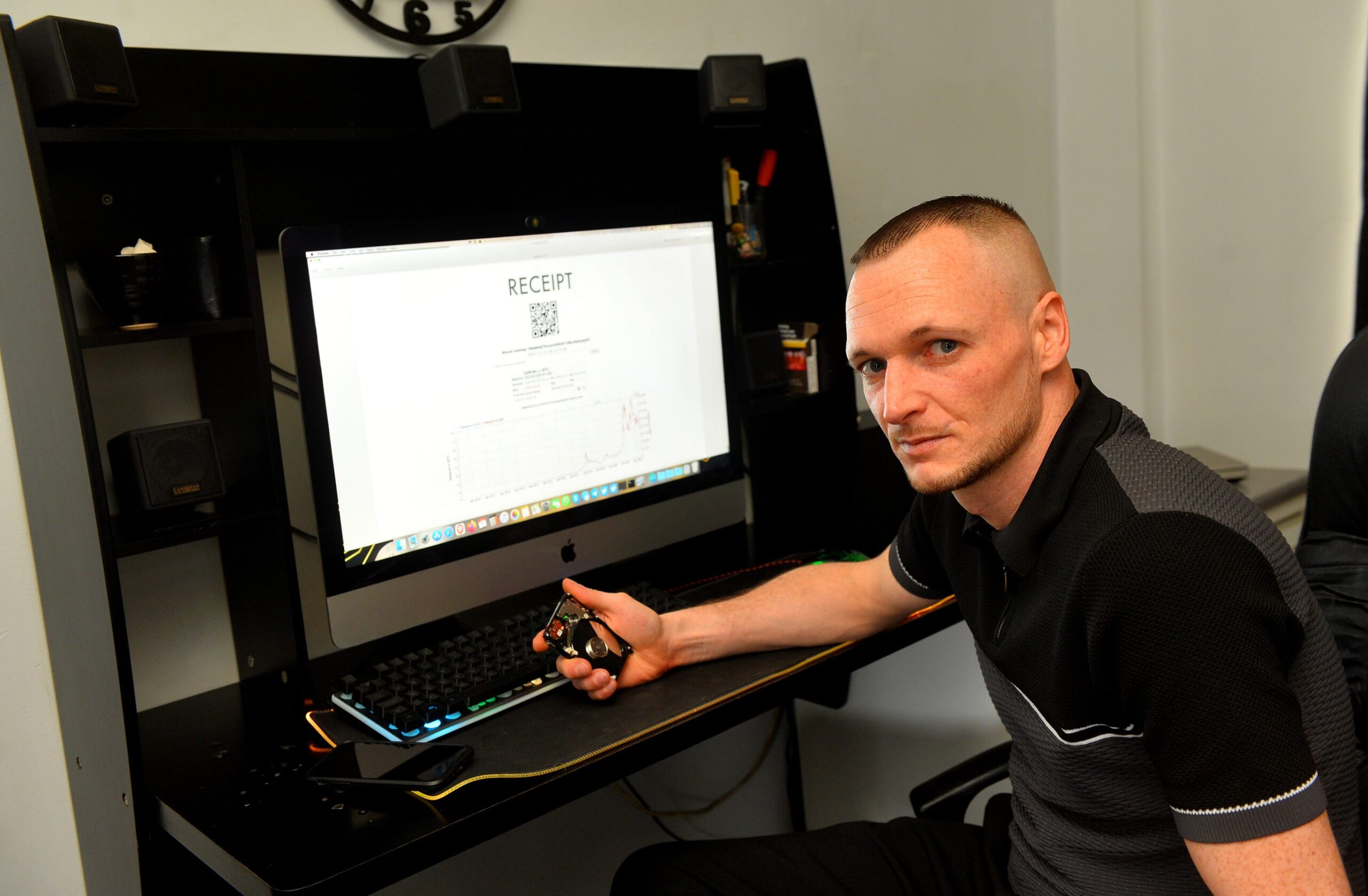He Tossed a Hard Drive with $1 Billion Worth of Bitcoin Into the Dump. Inside His All-Or Nothing Hunt For His Lost Treasure.

It’s estimated that the average human makes roughly 50 mistakes every day. Most are negligible. We drop our keys, we misspell a password. Every so often, though, we commit an error that proves indelible—a mistake that haunts us, grinds at our conscience, and causes us to lie awake at night, bug-eyed, asking ourselves, *Why? Why? Why?*
—
### The Lost Hard Drive and Millions in Bitcoin
In August 2013, a computer engineer named James Howells was cleaning his office when he opened a desk drawer and saw two old hard drives. One was empty and, as he saw it, useless and worth discarding; the other, from an old Dell laptop, had important data saved on it. He grabbed what he thought was the blank hard drive and threw it into a black trash bag.
Later that night, he asked his partner to take their refuse to their local landfill in Newport, Wales. Hafina Eddy-Evans balked at first, basically telling him she wasn’t his maid service. As Howells drifted off to sleep, he wondered if he’d tossed the right hard drive. He resolved to check the bag.
But the next morning, Eddy-Evans surprised him by reporting that she had actually gone to the dump.
Howells was drowsy then, but it was beginning to dawn on him that he may have made a colossal mistake. On that hard drive—from his Dell XPS M1710 laptop—was the only copy of the 51-digit key allowing him access to his cache of 8,000 bitcoin. Was that now in the landfill?
In the weeks that followed, he would not get much sleep at all, for the answer was yes.
—
### What is Bitcoin?
Bitcoin is the world’s most prevalent cryptocurrency. It was introduced in January 2009 to facilitate anonymous peer-to-peer financial transactions that bypass all banks, keeping ledgers on a blockchain shared globally across computers.
Howells was enchanted from the get-go. A plainspoken, pint-tippling everyman who left high school at 16, he disdains the “shadow banking world” that has, he argues, been “milking people for generations.”
In February 2009, Howells began mining bitcoin. He was a pioneer, almost certainly one of the currency’s first hundred miners. Plugging his computer into the bitcoin network, it solved myriad math puzzles to verify transactions, paying him a little bitcoin as a reward.
At the time, the currency was worthless. The first real-world bitcoin transaction didn’t come until the following year, when a software developer paid 10,000 bitcoin for two Papa John’s pizzas.
Just four years later, as Howells’s hard drive landed in the dump, his 8,000-bitcoin cache was worth about $900,000 and steadily increasing in value.
—
### Bitcoin’s Rise and Howells’s Plight
Today, Wall Street loves bitcoin. Even Donald Trump and his sons, Don Jr. and Eric—who have launched a mining firm called American Bitcoin—are involved. Bitcoin mining now accounts for up to 2.3 percent of the energy consumed in the United States.
Howells’s crypto wallet is currently worth about $800 million. The fateful moments of August 2013 haunt him like the trailer for a horror film: he tossed the drive with the password.
“She said she wasn’t going to go,” Howells recalls, ruminating on Hafina’s regrettable journey to the landfill. “Why didn’t she just do the thing she said she was going to do?”
—
### Lost Bitcoin: A Common Tragedy
James Howells is hardly alone in losing his bitcoin key. A 2023 report from Unchained Capital estimates that up to 3.8 million bitcoin, worth more than $400 billion, have been permanently lost.
Due to the unforgiving rules of cryptocurrency, there’s no customer service phone line to call, no auto-generated password recovery. The losers simply have to accept the loss.
Or maybe fight, as 40-year-old Howells has since 2015. He has devoted his life to recovering the lost bitcoin. He hasn’t worked a regular job and has repeatedly begged Newport City Council for permission to excavate the landfill—without success.
In January, after suing Newport for roughly $650 million, the judge dismissed his case, declaring that any exploratory dig had “no realistic prospect of succeeding.” The judge didn’t even consider the immense difficulty of actually retrieving data from a buried hard drive.
—
### Howells’s Determination and Public Offering
Despite detractors on social media calling him a loser and a moron, Howells has persevered. Working late into the night, he has assembled a bitcoin recovery dream team, including experts in landfill excavation, waste sorting, and data retrieval.
His X (formerly Twitter) banner now reads *NEVER GIVE UP* in steel lettering. On October 1, at Token2049—the world’s biggest crypto gathering in Singapore—he plans to offer 21 percent of his bitcoin’s value (around $170 million) to the public through token sales.
Anyone can invest online with as little as $500. If the hard drive is recovered, investors could get roughly two dollars for every one invested.
Howells aims to buy the Newport landfill—never mind that it isn’t for sale. “We’re gonna make them an offer they can’t refuse,” he vows.
His campaign embodies the bitcoin ethos: “No permission required.”
—
### The Challenge: Retrieving the Data
Finding the hard drive is one thing; accessing the data is another.
– Is the drive still intact?
– Do the internal platters still spin?
– Has the data survived corrosive landfill conditions or toxic chemicals?
Technology today allows many mistakes to be undone, but can it solve this problem? Is investing in Howells’s scheme wise? Christian Catalini, founder of the Cryptoeconomics Lab at MIT, cautiously says, “Maybe. It really depends on what the market estimates the chances of recovering the hard drive and its content actually are.”
—
### Who is James Howells?
Howells was born and lives in Newport, Wales—a rainy, Atlantic-side town with a history in coal and steel exports, and often described as depressed.
His father was a carpenter, his mother a factory worker making computer chips. An only child, Howells was often lonely.
When his family got their first computer in 1995, the 10-year-old boy dived into the online world, playing games like Quake and exploring Napster and Limewire, becoming a skilled network engineer by his tweens.
He also loved sports: soccer, rugby, and cricket, with a competitive spirit that forged his “never give up” mentality.
At 16, distracted by nightlife and disinterested in school, he left early to pursue his passion for tech.
—
### Early Bitcoin Mining
In 2009, Howells started mining bitcoin on a laptop at the foot of his bed. Noise from the laptop disturbed his partner Hafina, who wanted rest, so after 10 weeks he stopped mining, though reluctantly.
In 2024, Hafina told The Daily Mail she’d “love nothing more than [for] him to find it,” but she was “sick and tired of hearing about it.”
Howells now lives somewhat isolated with his dog, Ruby. With an unverified résumé and a wary demeanor, he might seem an unlikely hero. Yet, his dogged fight against bureaucratic inertia casts him as a champion of the everyman—albeit one who tossed nearly a billion dollars into the trash.
—
### Media Interest: A Docuseries in the Works
Hollywood media company Lebul, known for *Bride Wars* and *The Wolf of Wall Street*, plans a 10-part docuseries on Howells’s treasure hunt.
In its promotional poster, Howells stands back to the camera in a bleak landfill, arms ready for battle—an everyman fighting the frustrations of modern life.
—
### Can the Hard Drive Be Found?
The hard drive still exists—somewhere.
People have reclaimed lost items from landfills before. In New York City, residents can sift through trash at transfer stations for lost items. Success rates are about 50 percent, mostly for small valuables like rings and wallets.
But Howells’s hard drive lies under four feet of mud and rubbish amid 100,000 tons of waste at the 123-acre Docksway landfill, which has accepted trash since 1987.
Mark Hall, cofounder of UK-based Business Waste, estimated the chance of finding the drive at one in 902 million—a 0.00000011 percent chance. However, Michael Flynn, founder of the Irish FLI Group specializing in landfill remediation, calls that calculation nonsense.
—
### The Excavation Strategy
Flynn explains modern landfills are divided into cells about the size of a football field. Trash is layered, compacted, and capped with soil, making excavation complex.
The drive likely sits 2 to 10 meters beneath the surface.
Flynn joined Howells’s team in 2022, intrigued. He believes recovering a hard drive from a known landfill section is achievable if approached professionally.
His company has the right equipment, including a 20-ton Caterpillar excavator with a toothless bucket to avoid damaging the drive.
—
### Environmental Considerations
Landfills have delicate environmental systems, like methane discharge pipes and leachate collection systems carrying toxic liquids. The Docksway landfill also has a black plastic geomembrane lining under the waste to prevent soil contamination.
Digging must avoid damaging these systems to prevent environmental disasters.
—
### Sorting Through the Waste
After excavation, Howells plans to use AI-powered robots to sort debris.
Robotic arms will inspect material moving along conveyor belts, looking for objects resembling a hard drive.
The sorting technology from BHS (“Max-AI”) can distinguish hundreds of object types faster than humans but processing the entire cell’s contents at five tons per hour would take over two years.
—
### Data Recovery Challenges
Finding the drive doesn’t guarantee access to data.
The drive’s platters store bits magnetically. If they are broken or scratched, data could be lost.
Mike Cobb, director of engineering at DriveSavers, a data recovery company, is preparing strategies but remains cautious.
A crucial fact: Howells needs to recover just 51 characters—the bitcoin passkey—requiring only a microscopic section intact.
—
### Miracles in Data Recovery
Cobb recounts a remarkable case where an iPhone crushed by a snowblower was partially recovered by DriveSavers, restoring critical medical records.
Such miracles provide hope but do not guarantee success.
—
### Is Howells’s Investment Offer Fair?
The tokenization of Howells’s bitcoin aims to offer a two-for-one payout on investments if the key is recovered.
Cobb, with three decades in data recovery, refuses to make predictions until the drive is examined.
—
### Howells’s Complex Personality
In conversations, Howells expressed mixed feelings about Elon Musk, appreciating his vision but doubting his Mars ambitions due to political missteps.
Howells himself has burned bridges, suing the Newport Council and publicly calling his hometown “a dump” where people think bitcoin is a “scam.”
He says, “There’s currently $800 million on a hard drive in the ground with a little bit of soil buried on top, and the Newport Council won’t even have a sit-down conversation. That is insanity!”
—
### Isolation and Resistance
Howells acknowledges enemies in Newport and a growing loneliness.
Council officials and local journalists have been unresponsive to inquiries, leaving Howells to face the fight largely alone.
—
### The Future of the Landfill and Bitcoin Value
The landfill is slated to close within two years and become a solar farm. Environmental laws require aftercare for at least 30 years post-closure.
Climate change and flooding risks add urgency to resolving the site’s liabilities.
Meanwhile, bitcoin’s value continues to rise—from $75,000 in April to highs of $120,000 per coin—making recovery more lucrative by the day.
—
### Supporters and the Road Ahead
Jeff D’Agostino, a former actor and singer-songwriter, admires Howells’s early support for bitcoin, emphasizing the idealism behind it rather than money.
D’Agostino plans to buy Howells’s tokens and encourage others to do so.
On the Token2049 stage, Howells aims to dramatize his public offering with the ceremonial ringing of the bell, echoing New York Stock Exchange traditions.
—
### Homeward Bound
The day after the offering launch, Howells plans to return to Newport.
“It’s my hometown, isn’t it?” he says, with weary resignation. “I’ve always been here. My family are here, my friends. I guess I could move to Dubai or London or Miami, but I don’t see any benefit in doing that. I need to be here to dig this landfill. I’m not going to be distracted by anything else.”
—
James Howells’s story is a modern epic of loss, persistence, and the collision of technology, bureaucracy, and human will. Whether he recovers his treasure remains uncertain, but one thing is clear: some mistakes may define us, but the will to fix them endures.
https://www.popularmechanics.com/technology/a69045812/bitcoin-billionaire-dump/






